Release Date: October 15th, 1938
Series: Looney Tunes
Director: Bob Clampett
Story: Warren Foster
Animation: Bobe Cannon
Musical Direction: Carl Stalling
Starring: Mel Blanc (Porky, Mouse, Wolf, Chick), Berneice Hansell (Pinky), Tedd Pierce (Yell), Cliff Nazarro (Eddie Cantor)
It's a fate most golden age cartoon stars are delegated to at some point in their animated lives. Donald has Huey, Dewey, and Louie. Mickey has Mortie and Ferdie. Bugs Bunny has Clyde. Sylvester has Sylvester Jr., Daffy has countless kids and nephews alike.
As of Porky's Naughty Nephew, Porky has Pinky.
Pinky scratches an itch that would persist throughout much of Clampett's career: sickeningly cute characters performing sadistic acts of violence. Armed with Berneice Hansell's squeaky baby voice, which was often used as a means to annoy the audience as much as possible (a favorite strategy of Tex Avery's), giving Porky a sadistically cute nephew allows for many new opportunities with Porky. The shock value of a seemingly innocent baby who coos and giggles purposefully pretending to drown or cutting off a squirrel's head with scissors was a great vehicle for gags and laughs alike.
Though he only stuck around for 2 cartoons in the theatrical run, Pinky was later loosely adapted into Cicero in the Dell Looney Tunes comics, a kid as opposed to a baby more in the vein of Donald's nephews than what was Clampett's vision. As of Looney Tunes Cartoons, Cicero in those shorts has been adapted as a mix of the two, delivering violence onto Porky more in the vein of the Clampett cartoons as a troublemaking kid rather than seemingly innocent baby.
As the title implies, Porky's Naughty Nephew entails Porky and his eponymous nephew out on a day at the beach. While Porky seeks to relax in the sand and partake in a swim race, Pinky has other, more devious and violent plans. Faked drownings and shark attacks are only a small portion of his idea of a fun day out with Uncle Porky.
For the third cartoon in a row, Clampett establishes the exposition by irisng in immediately on a wooden sign advertising a "cartoon animals outing", the main event being a swim race. The postscript adding that elephants must wear trunks while swimming almost feels like something out of a Ben Hardaway cartoon rather than a Clampett short, though he too tended to indulge himself on many puns and radio catchphrases--often as a crutch.
In any case, the camera pans right to truck in on the background. A line of spherically designed animals of all shapes and sizes (an early Clampett trademark) march through the bathhouse, changing into their swimming suits without missing a beat. Carl Stalling's childish, slightly asynchronous music score of "The Animal Fair" is an appropriate fit for music; the slightly off-kilter arrangement cues the audience that this cartoon isn't mostly just facetious, cute animal hijinks.
With bath houses come bathing suit gags. An ambiguous bear/mouse/dog of Clampettian accord waddles up to a shower appropriately labeled "bathing suit fitter", a convenient solution to the animal's oversized bathing suit. Rather than having him waddle in a puddle of fabric draped below his knees, Clampett goes the extra mile and has the bear put the bathing suit over his ears, seeing as it's the only way it'll stay on. As a result, the visual gag is much clearer and amusing than if it were just a plain black puddle. Absurdity always triumphs.
The ambiguous animal turns the nozzle on the miraculous bathing suit fitter, allowing it to do its stuff. A stream of water showers the cub, and after the turns the water off, the bathing suit shrinks to the appropriate size with a fitting electric guitar twang sound.
Oh joy and rapture! He struts along on his merry way.
And, seeing as comedy comes from contrast, it's only fitting that the next patron in line is a portly pooch who can hardly keep himself in the confines of his own suit. The laughs primarily come from the haughty, pompous yet unassuming attitude of the dog rather than the size disparity itself; his utter nonchalance almost makes it seem as if he's above trite gags such as these, and he's well aware of it too.
With that, the only logical conclusion is that the reverse happens... but even then, Clampett still twists the audience's expectations. Instead of having the suit magically get bigger due to the water absorption, the dog instead grows smaller, hardly recognizable as he stands at a few inches tall. Size disparity gags are hardly anything new, even by 1938. Vestiges of the rubber hose days linger in this sequence, but doesn't necessarily come off as antiquated; the animation, especially of the dog, is funny enough and the gags are delivered with the same, lighthearted mischief that permeates through much of Clampett's work. As such, even if the gags are something the audience has seen before, it's hard to dislike.
Segue next to the stars of the cartoon. Berneice Hansell does what she does best: use her squeaky baby voice to amuse and annoy the audience. Hansell's vocals typically don't require any pitch manipulation, but here, they decided to speed up her voice just a tad to make her even more obnoxious.
As is the case with a number of Clampett Porky cartoons, Bobe Cannon animates Porky and Pinky's introduction, a babbling, excited Pinky skipping behind Porky, who's been tasked with lugging all of the beach supplies himself. The only thing more laborious than hauling all of the equipment is having to endure Pinky's breathless baby babble:
"Uncle Porky, can I go swimmin'? Oh boy! Buy me an ice cream cone! An' when's Christmas? Ohh, can I go swimmin'? When's the Easter Bunny comin'? Oh why? Oh boy! Oh, I wanna know about these things!"
Speeding Hansell's voices up and having her deliveries be nonstop is funny enough as is, but having Pinky ask if he can go swimming twice and ask a general "oh why?" drive the "toddler-who-asks-about-everything-and-never-shuts-up" vibe home perfectly. Everyone in their life has met a Pinky at some point (or has been a Pinky.)
Of course, to stop now would be futile. Pinky goes the extra mile to demand Porky's attention by climbing on him, tugging at his bathing suit straps and sticking his grubby little baby fingers up Porky's nostrils. The brief eyeroll from Porky is a wonderful, silent cry for help as Pinky blathers right into his ears. "How soon do we get there?"
Porky, ever the caring, kindred spirit, perfect at dealing with babies and cooing nothing but pleasantries at them, satiates Pinky's curiosity with an ever-considerate "Eh-keep your eh-puh-peh-pa-uh-uh-peh-eh-pehhh--diapers on!" Pinky flopping into place and Porky whipping around with only one in-between frame serves as a sneak peak to the rapid, elastic animation this cartoon is filled with, even by Clampett's standards.
While Porky traverses ahead, Pinky strikes the perfect "accosted yet innocent" baby pose, a coy finger in the mouth and vulnerable clutching of the bathing suit. Such a sweet little darling could never do any harm!
Right?
Even better than the derogatory tongue waggling is the speed in which Pinky reverts back to his coy little self.
At last, Porky is finally rewarded for his efforts as he finds a nice sand dune on which to set up camp. Stalling's music score does a great job of telling the story: there's a brazen, brass trumpet "wah" as Porky dumps his belongings on the ground, a drumroll as he prepares to stake the umbrella, and a cymbal crash when he finally plants it into the ground.
Or so he believes. A hulking bulldog erupts from the sand dune with a "YOOOOOOOOW!", tossing both Porky and his umbrella aside. The fact that the umbrella actually stuck in the dog's stomach (paired with Treg Brown's sound effects) does make the impact seem genuinely uncomfortable.
Porky is reduced to a shivering, craven shell of himself as he merely watches the bulldog punch him straight in the face. Cartoon physics ensue; both Porky and the umbrella are sent plummeting through the air...
...and land conveniently where Pinky is playing with some sand. Porky and the umbrella vibrate back and forth on ones, marked appropriately with a wobbling vibe chime sound effect. Pinky is (seemingly) oblivious.
Now, Porky flops into the sand with some signature Clampett-esque dizzy lines. When he sits up, he finds that what is reverberating back and forth is now his own head, not the umbrella. The drawings are amusing and almost (purposefully) disorienting shot on ones, paired with Treg Brown's sound effects that only seem to grow louder as Porky recovers.
He manages to halt the shaking by clamping his hands tight on his face...
...but, considering this is Porky, who's never been renowned for his luck, his snout begins to reverberate back and forth in place of his head.
Jump to a close-up of Porky keeping a careful eye on his affected snout. To remedy the predicament, Porky extends a cartoonishly long arm, hardly daring to move as he prepares to strike. Despite being a part of his own face, he acts like he's trying to swat at a fly, knowing one wrong movement could make it fly away--and, as a result, the entire charade is much funnier that way. It would be pretty boring if he just held it to a halt without all of the theatrics.
SMACK!
Porky almost looks startled, as if someone else smacked him in the face instead. That, paired with the pregnant pause as he keeps the hand on his face, again, makes it all the more amusing.
Success! Porky's self-satisfied grin to the camera as admittedly a relatively ugly drawing (the eyes are too close together and don't follow the construction of the head), but is funny, especially with Stalling's cheeky little flute motif, which is more important regardless.
Having survived such a taxing encounter, Porky settles in for a nap as we once more jump back to Bobe Cannon's animation. Pinky, occupied by babbling and playing with the sand, takes passing note of Porky. The aimless, insipid baby talk is a great way to make Pinky look sickeningly sweet--and, as a result, all the more devious. The double take he does realizing Porky isn't watching him says it all. Both the audience and Pinky know that no good can possibly come out of this.
That suspicion is validated as Pinky tinkers over to Porky, careful not to wake him up. Carl Stalling's dreamlike music score of "The Japanese Sandman" is a joke in itself and works in both a metaphorical and literal sense: Porky taking a nap, and Pinky playing in the sand.
Cue the inevitable as Pinky winds up to smack Porky right in the face with the shovel. Perhaps even funnier than the gag itself, where this seemingly adorable little baby is actually a sadistic little devil, is the timing; as soon as Pinky smacks Porky in the face, he immediately rushes back to his post, playing with the sand and babbling incoherently. For a split moment, before he makes a break for it, Pinky stuffs his finger in his mouth in the default "ain't I cute" pose, as if preparing for a backup plan, like Porky would bust him right then and there.
The drawings of Porky's take as he wakes up are hilarious and look great in motion, and having his tail stick straight up is a nice little topper. Timed to some string chords from Stalling, Porky first looks straight ahead and then at Pinky, trying to identify the culprit.
Porky casts a quick smile at seeing Pinky being the good, innocent little dickens he is, babbling and playing in the sand. The goo-goo and ga-ga-ing is almost more sadistic than the smack itself.
Instead, Porky swats at the air with a scowl before chuckling at the audience.
"Heh, feh-eh-flies." His compulsion to justify the violence is nearly as amusing as his deduction that a fly could cause that much pain. One questions the kinds of flies Porky Pig has encountered.
With that, Sherlock returns to his nap, which prompts Pinky to continue in his masochistic endeavors.
That is, until Porky whips around and shoots another glance at Pinky, just to be sure. With some sharp comedic timing, Pinky makes it back to his sand pile just in time. Treg Brown's "whoosh" sound effect (which wasn't present in Pinky's first breakaway) does a great job at conveying the necessary cartoonish urgency, in both Porky's potential confrontation and Pinky's escape.
Bobe Cannon's drawing of Porky shrugging is great, marked by a trombone slide for extra "what are ya gonna do" emphasis.
Comedy is always done in threes. Since the audience anticipates Pinky getting another hit in, Clampett doesn't waste any time with his furtive tippy-toe walk, instead having him march straight over to Porky at regular speed.
A wind up for good measure...
It is cartoon law that injuries can only be performed when timed percussively to "Shave and a Haircut". This particular print of the cartoon has an error where dark splotches where the shovel was/is momentarily fade in and out of place, but, miraculously, almost work in the context of the blows, as if to represent Porky seeing spots in the midst of his bludgeons.
Even still, Porky has yet to confront Pinky, who zips back to his post. After yet another crazy 360 head spin, he prepares to lay into whatever culprit lies before him.
Pan left to reveal a hilariously Clampett designed baby (branded as such by the lone baby hair and single tooth) wielding a shovel and pail. Pinky's violence doesn't only hurt his victims--it hurts innocent bystanders too.
Porky's dialogue of "Hey, sonny!" makes him sound like an old geezer, ruining any dignity that can be had when chastising a mindless, innocent baby--which is exactly the point. "You eh-muh-me-me-me-me-mih-musn't do eh-the-the-the-ehhh... stop it!"
The scowl on Porky's face as he confiscates the poor thing's shovel is hilarious; had any passersby witnessed the encounter, they'd think Porky was a heartless monster picking on an innocent waif. Perhaps there is a bit of truth in that statement.
Or, perhaps not. Still boasting a hilariously vacant grin, the Shovel Baby produces yet another shovel, now bigger in size.
Cue more rapid head spinning from a flabbergasted pig.
Shovel number two is also promptly confiscated, this time with Porky rocking on his heels, maintaining that twisted grin--it looks as though he's dangerously close to putting the shovel to use.
The baby beats him in that department as well. Again, seeing as comedy comes in threes, the baby now wields a ginormous shovel, smacking Porky over the head and reducing him to a puddle of pig flesh.
His recovery (or lack thereof) is just as elastic, wobbly, and loose as the rest of the animation in this cartoon, his head ringing once more as he aimlessly wobbles in place. Clampett loved to draw characters with crossed eyes and protruding tongues, and here he scratches that itch with Porky--who, as a typically more conservative character, is extra fun to see in such a state.
Cut to John Carey's animation as we jump to a wide shot of the still incapacitated porcine. Now, Pinky takes matters in his own hands, completely dropping the innocent baby shtick as he squeaks "HEY, YOU! LAY OFF MY UNCLE PORKY!"
Porky aimlessly swaying off to the side, completely incognizant, is hilarious in its own right. In any case, Clampett chases more laughs as Pinky grabs the shovel with little effort exerted, taking a heaping big swing.As it turns out, all babies are the same. The seemingly blank and nescient baby exudes his own sadistic tendencies as he bends low to the ground, adding insult to literal injury as he merely rests his head in his hand, posing for the act. Porky is the victim of Pinky's violence yet again, sent tumbling into the air before flopping unconscious on the sand.
Perhaps the most amusing of all is the way Pinky returns the shovel back to the baby with a smile, as if they were working in a planned tag team effort. Sadistic infants must stick together in the face of finger wagging, oblivious adults.
Seeing as he's exhausted nearly all methods of physical abuse for the time being, Pinky instead switches to more psychological tactics instead. Spotting a nearby pond, he tinkers into its shallow depths (with a great, completely arbitrary detail of him hiking his swimming trunks up), nestling in on his back with a gleeful shimmy.
Poking his pudgy belly so that it's concealed by the water, Pinky, master sadist, thusly pretends to drown, crying for Porky's help without even bothering to hide his wide smile. If this is just a day out to the beach, one wonders what a typical day of babysitting Pinky entails. Does he have a vendetta for Porky and Porky only? Is it just in his nefarious nature? The world may never know.
Pinky's cries for help revive Porky from his beating. John Carey's animation of Porky scrambling to the rescue, momentarily flashing the audience as he leaps out of his stagnant swimsuit, is an elastic wonderment; some very fun freeze-frames, antics, smears and overshoots. (There's even a brief moment where the inkers colored him white instead of his usual light gray.) Bob Clampett seemed especially fond of gags where Porky jumps out of his clothes or his own skin.
The animation of Pinky "drowning" is admittedly much cruder than Bobe Cannon's, but still made amusing by Porky's reaction as he prances back and forth rather than diving straight in.
Eventually, however, he does dive. In a great little detail, Porky briefly flashes a borderline smug, content expression as he dives like a graceful Olympic athlete. Now is not the time for theatrics, which is why said theatrics are especially amusing as a result.
Back to the physical abuse as Porky lands headfirst in the shallow water, swimming aimlessly before his brain catches up to him. Pinky is positively beside himself with giggles.
Clampett continues to push the envelope by having Porky pluck himself out of the water, a starfish (freshwater be damned) stuck straight to his face.
All the more fun for Pinky. Norm McCabe's drawings are a breath of fresh air when juxtaposed with the last scene--much more solid, appealing, and funny. Pinky's squeaky giggles of sadistic delight are infectious, especially paired with Porky's contemptuous and befuddled glowers at the starfish hugging his mug. Stalling does a signature "laughing" descending scale for the underscore, which makes the scene read as much more mischievous and lighthearted rather than truly painful or uncomfortable.
In the midst of Pinky's laughing fit, Porky attempts to remove the pond sea star from his countenance. No such luck, but it does give us these wonderful drawings from McCabe. Lots of physical gags with Porky this time around, which is always nice to see. Treg Brown's smacking sound effects elevate this from your typical "dog stuck to flypaper" routine into something more painful and insulting. The fractured star special effects are a really nice, whimsical, graphic embellishment that harken back to Clampett's comic strip-centric roots.
Props to McCabe for managing to convey Porky's contempt and disgruntlement so clearly when a starfish is taking up 3/4 of his face. The glower he shoots Pinky is priceless, and much funnier with his mouth concealed. His rage permeates the starfish.
Despite Pinky's behavior thus far, even he has a breaking point. Now for a more gentle scene as Pinky coos "Oh, poor Uncle Porky... lemme take it off." Stalling's reserved score of "Daddy's Boy" is a nice tongue-in-cheek attempt to make the scene more endearing, which is a joke in itself--especially with Porky consistently glaring at Pinky, even as he tries to get on his good side.
"Easy now... easy...!" It's as though Pinky is babysitting Porky and not the other way around. Again, the magic is in the sound effects; McCabe's animation of Pinky jarring the starfish loose from Porky's flesh doesn't necessarily inform the pain of the starfish's suction being cut loose. Rather, it's Treg's Velcro ripping sound effects, long and drawn out for maximum uncomfortableness.
After some poking and prodding and nervous "Ohhh..."s from Pinky, he finally rips the starfish loose from Porky's visage.
Porky thanks him with an ear-splitting "YYYYYYYYYYYYYYYYEEEEOW!" At one point, he literally shakes with rage.
While Porky shoots him one final glare, Pinky displays the freed starfish as though its a trophy. Norm McCabe was the perfect pick for the scene--had an animator with weaker draftsmanship been cast instead, the scene could unintentionally come off as cloying and tedious; the very thing it is fighting against. McCabe's drawings are funny in both an earnest and tongue-in-cheek level.
Cross dissolve to a more staid scene of Porky and Pinky moping in their separate ways: Porky idly kicking at the sand and Pinky playing in said sand without any of the baby babble fodder. The bandage on top of Porky's head is an interesting design choice; it's relatively difficult to show any injury left by a starfish on the face, and the somber attitude wouldn't work nearly as well had Porky been in perfectly fine condition. As a result, the bandage is more of a representation of his injuries rather than a practical solution to aiding them.
The squeak in Berneice Hansell's voice as Pinky apologies ("Gee, I'm AWFUL sorry, Uncle Porky!") is a wonderful reminder of just how powerful Hansell's vocals are--especially when sped up to be extra annoying. A sense of satisfaction at his own deeds still lies strongly in Pinky's delivery. Sorry never truly means sorry.
Clampett touches on that further as Pinky promises to be good "forever and ever", which Pinky, the audience, and even Porky know, marked by Porky avoiding eye contact rather than forgiving him.
In any case, Porky's good heart prevails (to a fault) yet again, striking a forgiveness deal with Pinky when he offers to cover him with sand. Surely no harm nor foul can come out of such innocent child play.
Or can it?
As is usually the case, the idea of a toddler conveniently finding and operating a dump truck full of sand and drowning his uncle in it is funny enough in itself, but the speed in which the gag is executed--no cuts to Pinky finding the truck or climbing into it, no beeping sounds of the truck backing up, just Pinky zipping off-screen and returning so quickly that the truck itself jiggles for a moment--is what really carries the gag. That, paired with Stalling's reflectively brassy and jovial underscore, a significant change from the endearing violin strains of "Daddy's Boy" just seconds prior.
Interestingly, it looks as though Bob Clampett switches animators halfway through the scene. Bobe Cannon animated both the wide shots and close-up, but after Pinky pours the sand on Porky, John Carey takes over, marked primarily by Porky (and Pinky's) long snouts and tall, thin, pill shaped eyes.
Clampett was no stranger to switching animators through his scenes, and did it quite often, especially throughout much of his later work. To see such an obvious switch so early on is rare and rather curious; did he think Carey's animation was the better fit for the remaining needs of the scene? Did Cannon get injured? Sick? Had to take time off? Again, the world may never know. It's purely food for thought, but interesting to see the beginnings of a trend that would pop up in many Clampett cartoons later on. The difference is certainly noticeable when comparing side by side.
In any case, Porky is more preoccupied with spitting sand out of his mouth rather than pondering his artistic origins. Pinky, as one can guess, is in stitches yet again at his deviousness.
Enough abuse--both porcines take note of the horn trumpeting off-screen instead. Carey's animation is wonderfully elastic, and there's a wonderful handful of frames where Pinky perks his ear up, straining to identify the noise.
We cut to the source of the commotion: a Daffy facsimile trumpets the fanfare through his own beak. He strains to get the last note out, an accurate reminder not to expect any sincerity.
No dialogue necessary. The duck wields a sign advertising the swim race, prompting an audience of off-screen onlookers to shout "WHEN?"
Only in a Clampett cartoon is a duck's ass pivotal to moving the story along.
In an instant, the poor duck is ambushed by a crowd of eager animals, mowing him over to a frenzied motif of "The Animal Fair". Ducks, geese, pelicans, chickens, and dogs are a small assortment of the crowd contributing to a mass trampling.
Stalling's music score grows quiet as we study the aftermath of a cartoonishly flattened duck. He jerks his head up as though to reassure us he's okay, only dazed...
Cue the lone straggler who mows the duck down once more, a gag that calls to mind the cartoons of yesteryear. Stalling's xylophone flourish and the odd quack-adjacent sound of the duck getting trampled elevate the joke slightly and prevent it from being too routine.
After a wide shot of the animals aligning for the race, we cut to Porky, who's still buried in the mound of sand. He too exhibits the enthusiasm of the other racegoers, so eager to participate that he grants the audience some full frontal nudity as he dashes out of his swimsuit a second time, kicking a plethora of sand loose from his accoutrements.
With that, he skids to a halt, nestling in between a cotton tailed deer and a pelican synonymous in design to the one in Porky & Daffy. All of the animals are certainly pungent with Clampett's design sense.
Speaking of Clampett's design sense, the referee, a sphere-headed mouse with a "mask" around the eyes, pear shaped body, suspenders, and touting large shoes is indeed full of Clampett's sensibilities. That, of course, paired with the giant pistol he holds in a rubbery hand, the gun 3x as big as he is. There's no cute animation of the mouse struggling to maintain the gun's weight--that's not where the humor comes in. The humor is involved in the size disparity to begin with, as well as his deep, gravelly signature Mel Blanc yell as he announces in a New York accent:
"GET ON YA MAHKS..."
"...GIT SET..."
He braces for impact, the drumroll music score growing louder as the mouse squeezes the trigger. That, along with the staggered animation and screwing shut of the eyes, prepare the audience for a very loud, explosive impact.
That is, an explosive impact straight out of the Harman and Ising days. In a tried and true gag, the mouse doesn't fire an ear-splitting blank. Instead, a stoplight erupts out of the pistol, a brief pause before the "GO" symbol is given.
As per the cue, all of the animals embark on the race...
...but in completely opposite directions. Porky is the only one who dives straight in the water, while the others make a mad dash off-screen. There are plenty of gags present in the designs of the animals alone--a group of chicks cling to an ostrich's tail, reminiscent of a similar scene that Bob Clampett himself animated in Tex Avery's I Love to Singa. A not-so-subtle nod to one Mickey Mouse is also present in the crowd--the last one to make it off-screen is a black mouse with a white face and boxers, which is definitely not a coincidence. Not in his size or design.
A pause as Porky takes the lead, which is only then interrupted by the stampede of the returning animals. Now, they return armed with all sorts of instruments allowing them to cheat. One duck rides in on a paddle-board unicycle. Another rides a bicycle straight into the water. Mickey has water wings, an ostrich has a motor, a chicken has a surfboard. The moose returns with an innertube, while a goose shoves its rowing team family into the water, all equipped with a canoe and paddles. Wacky races ensue.
Of course, it wouldn't be a race without an announcer. A wolf at the press box howls "THERE THEY GOOOOOOOOOOOO!", the KFWB microphone (a nod to the Warner owned radio station) extending to match the rubbery stature of the wolf as he bays.
There are essentially two portions of the swim race: the Bob Clampett portion and the Bernard Brown portion. Many of the gags and even footage are reused from Brown's 1934 entry Pettin' in the Park, whether due to a lack of inspiration, saving money, or both. The scene of the duck riding the paddle board and smacking Porky repeatedly in the face is indisputably of Clampett heritage.
On the other hand, the scene of a duck struggling to pedal a bike through the hills in the lake are from Brown's end, the animation taken straight from the aforementioned cartoon. The shift in the skinnier, lanky, more streamlined Clampett designs to the bulbous, rubbery mid-'30s Brown designs is relatively noticeable to dedicated viewers, but not enough to be jarring--especially not for theater audiences.
In any case, the reuse fares better than its initial usage in Park; the duck descends a hill so steep that its legs go out of control, submerging the duck in the water. The initial animation lacked a strong sense of weight or urgency, with rather crude water effects. Now, a plume of water erupts when the duck sinks rather than a small splash, and instead of riding out the original gag where the duck emerges trapped in a bubble, Clampett switches to the next scene, leaving the bird's mortality up to the imagination of the audience.
Another reuse from Park has an ostrich stumbling over a dresser left at the bottom of the lake (a gag with very strong early-'mid '30s sensibilities and whimsy), its neck sticking out the top drawer as the remaining draws open and close with each footstep. While the animation of the drawers is still crude and wobbly, Treg Brown's sound effects of the sliding drawers does a better job of suspending the audience's disbelief, seeing as the sound effects were not present in the original cartoon. The ostrich also doesn't float to the top of the lake, struggling to kick its legs and swim as it does in the original. Clampett continues to cut from one action to the next.
Our next scene combines both old and new animation. Old is the animation of a pelican spitting an arc of water over himself as he swims, new is the animation of a hyper-realistic (by Clampett's standards) jockey and his horse riding through the water. While a lanky, elastic Clampett human design would work fine, the juxtaposition between the two animation styles already inherent by the sensibilities of the directors, taking a more realistic approach with the horse and jockey make the contrast all the stronger and thusly ridiculous. The joke is that the two are out of place. Having the animation purposefully be jarring and incongruent saves it from being too trite and works in its favor.
Even then, the jockey and horse begin to sink in the water, prompting the horse to revert back to more Clampett-esque proportions as he does a take with a whinny.
Now, he chastises his jockey in a voice close to the one Blanc would use for future Joe Besser caricatures: "This CAN'T be Santa Anita!", with Santa Anita Park famous for its horse races.
They too, like the duck on a bicycle, submerge beneath the water, their fates left unknown. A mass casualty event?
A gag from Park is given a new polish of paint with new Clampett animation as a goose struggles to keep up his momentum, a car horn appropriately honking each time he thrusts his lanky neck forward.
"Stroke! Stroke! Stroke, stroke, stroke!" A canoe filled with professional baby chick rowers pass the exhausted goose. The lead "instructor", voiced in a wimpy falsetto from Blanc, even has a megaphone strapped to his mouth. Park had a line of chickens as the rowing team, the boat full sized and the lead chicken squawking aimlessly. By making the rowing team smaller in size (and age), the concept is made a bit funnier as compared to a straightforward delivery of the gag.
Of course, being Clampett, we go the entire way and have the dead eye-ing goose swallow the rowing team instead, the paddles now being swung inside his belly instead, giving him an extra boost. Blanc's instructions of "Stroke, stroke stroke stroke, stroke, stuh-ROKE!" continue on.
Even then, we still see a rowing team of actual chickens included in the line of animals passing a buoy, marking the turning point. Ambiguous honking ensues all the while as a straggler duck approaches the buoy.
Close-up on said duck, who is no duck at all, but instead a random caricature of vaudevillian and radio personality Eddie Cantor, no stranger to the world of WB cartoons. He crashes straight into the buoy, following in Porky's footsteps as his head reverberates from the impact, the shot double-exposed to convey a more dreamlike, blurred, rapid sense of motion.
Another Porky-esque head spin as he spots the buoy in front of him; the long eyelashes and shiny eyelids are an amusing design choice. He almost looks like a cousin of the numerous Peter Lorre caricatures prominent in later cartoons.
Instead of getting upset, Stalling initiates a celebratory music cue of "Dear Little Boy of Mine" as Cantor performs a trademark hand clap, staring at the audience with his giant, bulging eyes. A number of cartoons, such as Shuffle Off to Buffalo and Billboard Frolics, have lampooned Cantor and his mannerisms--eye rolls, claps, the like. While he's fallen to obscurity to audiences today, one can still appreciate the execution of the celebratory hand clap he does, the animation hilariously rapid and reflected as such with the sound effects. Audiences then would have found it amusing, accustomed to his mannerisms. Audiences today can still appreciate the funny clap the weird guy with the big eyes does. The success of the joke doesn't entirely hinge on understanding who or what the caricature is, though it does certainly help.
Cue the obligatory eye roll. "At last!" Cantor gesticulates towards his obstacle, leaning towards the audience, "a BUOY!"
He cradles his newfound love in his arm, vindicated by his awful pun. Cantor's 5 daughters were a common gag in the Warner cartoons, with Bob Clampett particularly poking fun at Cantor wanting a son. In his 1946 cartoon Baby Bottleneck, Daffy at one point asks "Oh yes, Mr. Cantor! Ya say ya haven't got that boy yet? Well, if at first you don't succeed...!", whereas Clampett's Slap Happy Pappy in 1940 is an entire cartoon dedicated to a Cantor chicken pursuing a son.
In any case, the climax of the race is now scored by a jolly rendition of "The Latin Quarter", as if to signify the last quarter of the race. A duck who strongly resembles Daffy's 1939-1940 design in Clampett's cartoons passes a deer struggling to maintain his speed.
Seeing that he's falling behind, he enlists in the powers of cartoon physics at hand.
Viola! Instant sails. He surpasses the duck with a wide, toothy grin.
Porky, who's been AWOL for the past minute and a half, is the lone straggler of the race, only just now making the turn around the checkpoint buoy.
Thankfully, he's granted a little moral support by his innocent little nephew, hiding out inside the buoy. Perhaps Cantor truly did get his boy--a REAL one--after all.
Pinky's next line of attack involves a toy sailboat, which he winds up in a brief (admittedly crude on Pinky's end) close-up shot. Having wound the toy up to an acceptable rate, he releases it into the water.
"A shark! A shark!"
Cut to the sailboat in the water, slowly submerging as it picks up speed. Clampett would later reupholster the animation of the sail turning into shark fin shaped perspective in The Sour Puss, where Porky is the one warning about the "shark" as opposed to the one being warned.
Clampett seemed fond of his double takes. Porky did the same half-hearted double take in Porky's Party as he does here, acknowledging the fin behind him as he continues to swim on before recognizing the threat.
Now, Clampett borrows from himself as Porky does the same naked swimsuit scramble as he did when Pinky was drowning. His "YYYYYYYYYYYYYYYYEEEEOW!" is also borrowed from his tenure with Pinky ripping the starfish off of his face.
In any case, Pinky's prank actually brings some good: Porky aimlessly flails past all of the contestants in the race, passing them in a breeze. Actually showing Porky flailing about and speeding up the camera pan is much more amusing than a puff of smoke (or water, in this case) as Porky zips off-screen. Displaying the action caricatures and prioritizes his cravenness and alarm more than a caricature of the action itself, which works in the gag's success.
It also works in Porky's success, who wins first place as he makes a mad dash past the finish line and right into a tree. Miraculously, no head reverberations.
Rather, Porky leans against the tree, his knees trembling as he observes the shark circling before him. Knowing Clampett's complaints about the sound effects in The Daffy Doc being too realistic and thus a detriment to the gags therein, his caricature of action and sound becomes increasingly noticeable and commendable. It's noticeable in this case--instead of having sticks clacking together or a wobbling sound, Treg Brown instead accompanies Porky's tremors with the sound of a dog panting; an odd choice on paper that works surprisingly well.
Pinky arrives to do what he does best by calming Porky's strained nerves. "Looky, Uncle Porky! It's only a li'l toy sailboat."
"See?" Karmic (in)justice for Pinky, who unearths a real live shark from the water. "Just a li'l toy sailboat!"
One more "YYYYYYYYYYYYYYYYEEEEOW!" from Porky for good measure as he repeats the take he did when he was awoken from his nap, scrambling to escape off-screen. Now, Pinky does his own "WOOOOOAH!", performing his own gelatinous gymnastics before he heads for the hills.
Interestingly, it seems that Clampett switches animators AGAIN--instead of switching from Cannon to Carey, it looks like a switch from Carey to Cannon. Porky has tall eyes and an elongated snout during the first portion of the scene, and after Porky leans against the tree and Pinky comes in, Pinky has the signature Cannon buck teeth and Porky's take matches with one he did earlier. Clampett must have thought the two animators flowed together nicely.
With that, we iris out on a thoroughly perplexed shark.
The 1938-1939 season for both Looney Tunes and Merrie Melodies alike begins to show slight signs of decline. 1937 was a peak year in the acquisition of Mel Blanc, promoting Bob Clampett to a director, redesigning Porky, and the creation of key players such as Daffy and Elmer (albeit in prototype form.) The directors continued to hit their stride into 1938, with the cartoons making a considerable name for themselves. Years of imitating Disney has finally began to come to a close.
As such, peaks and falls are bound to happen. 1939 was a noticeably weaker year--Tex Avery's filmography was largely travelogues, Chuck Jones' cartoons certainly looked nice but were very seldom fast nor hilarious, Ben Hardaway and Cal Dalton continued to produce one mediocrity after the other, and Bob Clampett began to feel suffocated by his contractual obligation to make nothing but Porky cartoons.
A bit of that Porky exhaustion begins to eke its way in this cartoon. Throughout 1939-1941, in the midst of his Porky embargo, Clampett used Porky cartoons as a vehicle to show off more eccentric and zany characters, sidelining Porky to a supporting role in his own cartoon. That sidelining is felt here; the swim race portion almost takes up almost half of the cartoon, and Porky is scarcely included in it. Along with the reuse of animation and gags (swim race or not--a new drinking game could be made when counting how many times a character spins their head 360 degrees in a take), there reads a general lack of inspiration, whether intentional or not.
However, seeing as Clampett's last cartoon was Porky in Wackyland, one of the most oddball cartoons period and quite earned in its notoriety, it's only fair that the next cartoon won't be up to the same standard. And even then, Porky's Naughty Nephew is still a very fun and lighthearted cartoon. Clampett at his worst is mediocre, phoned-in, which is a miracle in itself. His cartoons are very hard to actively dislike.
In any case, Nephew is above that mediocrity. It is a step down from other cartoons in his filmography thus far, but when it's good, it remains good, and a number of issues present in this cartoon were ironed out in Porky's Picnic a year later, starring Porky, Pinky, and Petunia. Norm McCabe's drawings of Porky wrestling with the starfish are hilarious and some of the wildest drawings we've seen in a Porky cartoon thus far. Berneice Hansell kills it as Pinky, the squeaky voice cracks and purposefully coy baby babble only making his sadism that much stronger. The comedic timing of Pinky slapping Porky with the shovel is very well executed, and even the recycled animation is punched up--splashes and impacts are made bigger, more refined, cuts are made so as not to linger on any one gag too long, and the reusage at least comes off with a sense of coherency and purpose rather than haphazardly slapping something in and moving onto the next piece of business.
In spite of its flaws, Nephew is still a very fun cartoon with great voice acting and an amusing premise that could come off as incredibly trite or saccharine had it been in the hands of the wrong direction. Pinky's sadism is almost a little too much--seeing Porky taking a beating without a chance for a comeuppance is unpleasant, and the directors strayed away from this when they could. Even in Porky's Picnic, when Pinky slaps Porky with a 2x4, Porky makes a remark to the audience by pretending to cut Pinky's head off, which is more retaliation than he was granted here. In any case, too much sadism is a better case scenario than too sweet and trying too hard to be funny. Nephew does what it does well, and maintains an infectiously mischievous energy.
Enjoy! The cartoon is also available on HBO Max for those who have it.


























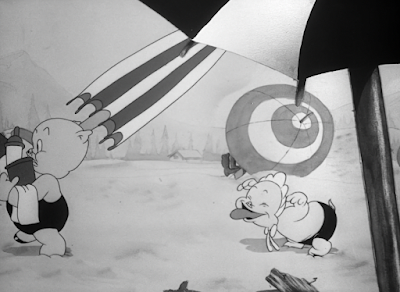



































































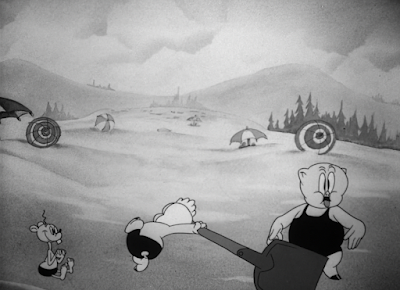
















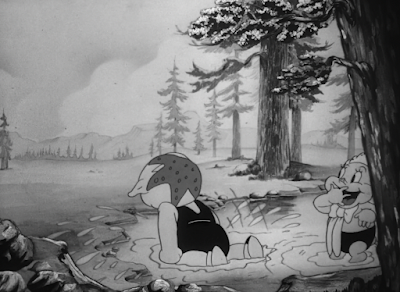










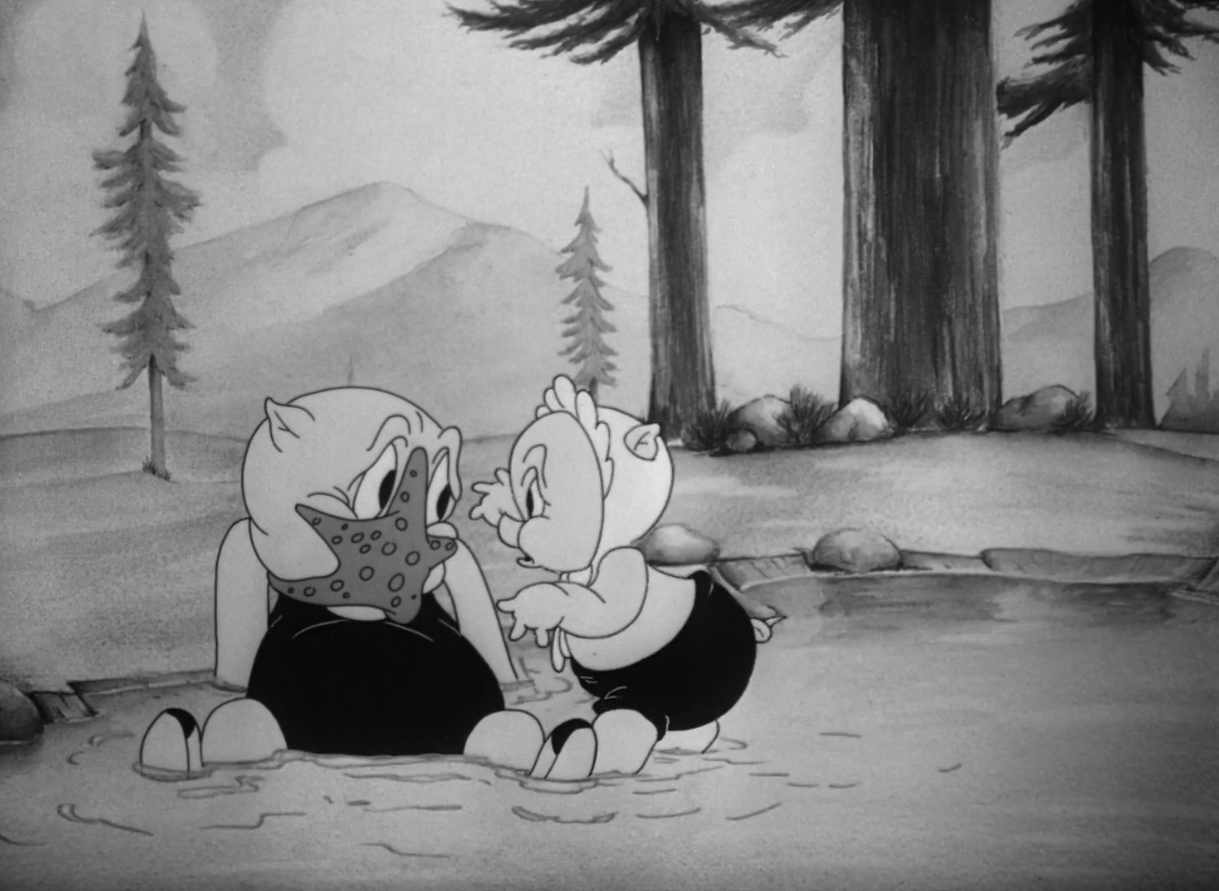

































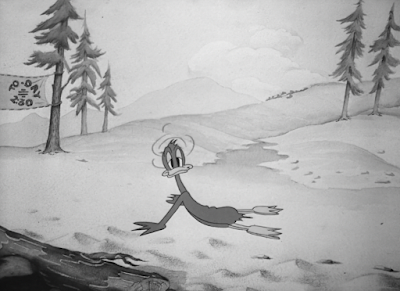
































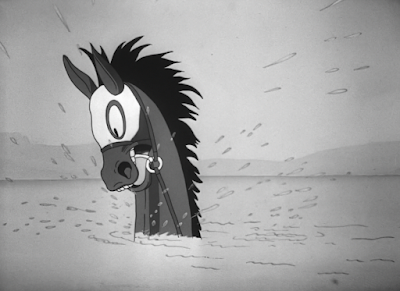







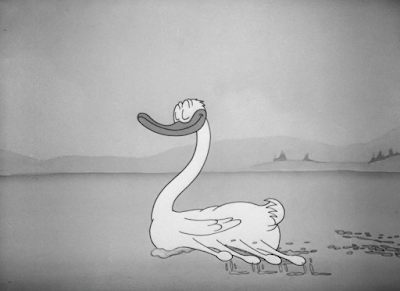











































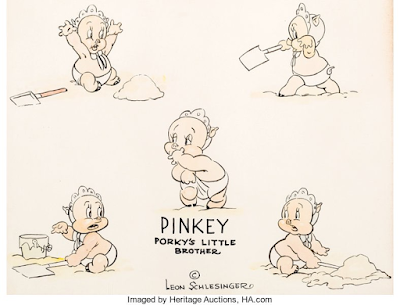




No comments:
Post a Comment